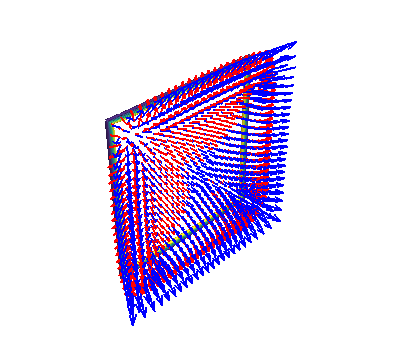Note
Click here to download the full example code
Spherical harmonics B-field computation validation¶

Out:
l = 1 computed
l = 2 computed
l = 3 computed
l = 4 computed
l = 5 computed
l = 6 computed
l = 7 computed
l = 8 computed
l = 9 computed
Computing magnetic field coupling matrix, 676 vertices by 676 target points... took 0.13 seconds.
Relative RMS error 0.5606404914507133
import numpy as np
import trimesh
from mayavi import mlab
from bfieldtools.mesh_magnetics import magnetic_field_coupling
from bfieldtools.mesh_conductor import MeshConductor
from bfieldtools.sphtools import compute_sphcoeffs_mesh
from bfieldtools import sphtools
import pkg_resources
# Load simple plane mesh that is centered on the origin
file_obj = pkg_resources.resource_filename(
"bfieldtools", "example_meshes/10x10_plane.obj"
)
coilmesh = trimesh.load(file_obj, process=False)
coil = MeshConductor(mesh_obj=coilmesh)
coil.mesh.vertices += np.array([0, -1, 0])
weights = np.zeros(coilmesh.vertices.shape[0])
weights[coil.inner_vertices] = 1
test_points = coilmesh.vertices.copy()
test_points[:, 1] = 0
lmax = 9
sph_C = compute_sphcoeffs_mesh(coil.mesh, lmax)
alms = sph_C[0] @ weights
blms = sph_C[1] @ weights
alms = np.zeros_like(alms)
B0 = (magnetic_field_coupling(coilmesh, test_points) @ weights).T
B1 = sphtools.field(test_points, alms, blms, lmax).T
mlab.figure(bgcolor=(1, 1, 1))
s = mlab.triangular_mesh(
*coilmesh.vertices.T, coilmesh.faces, scalars=weights, colormap="viridis"
)
s.enable_contours = True
s.actor.property.render_lines_as_tubes = True
s.actor.property.line_width = 3.0
mlab.quiver3d(
*test_points.T, *B0, color=(1, 0, 0), scale_factor=0.5e7, vmin=0, vmax=2e-7
)
mlab.quiver3d(
*test_points.T, *B1, color=(0, 0, 1), scale_factor=0.5e7, vmin=0, vmax=2e-7
)
s.scene.isometric_view()
print(
"Relative RMS error", np.sqrt(np.mean((B1 - B0) ** 2)) / np.sqrt(np.mean((B0) ** 2))
)
Total running time of the script: ( 0 minutes 31.796 seconds)
Estimated memory usage: 71 MB
